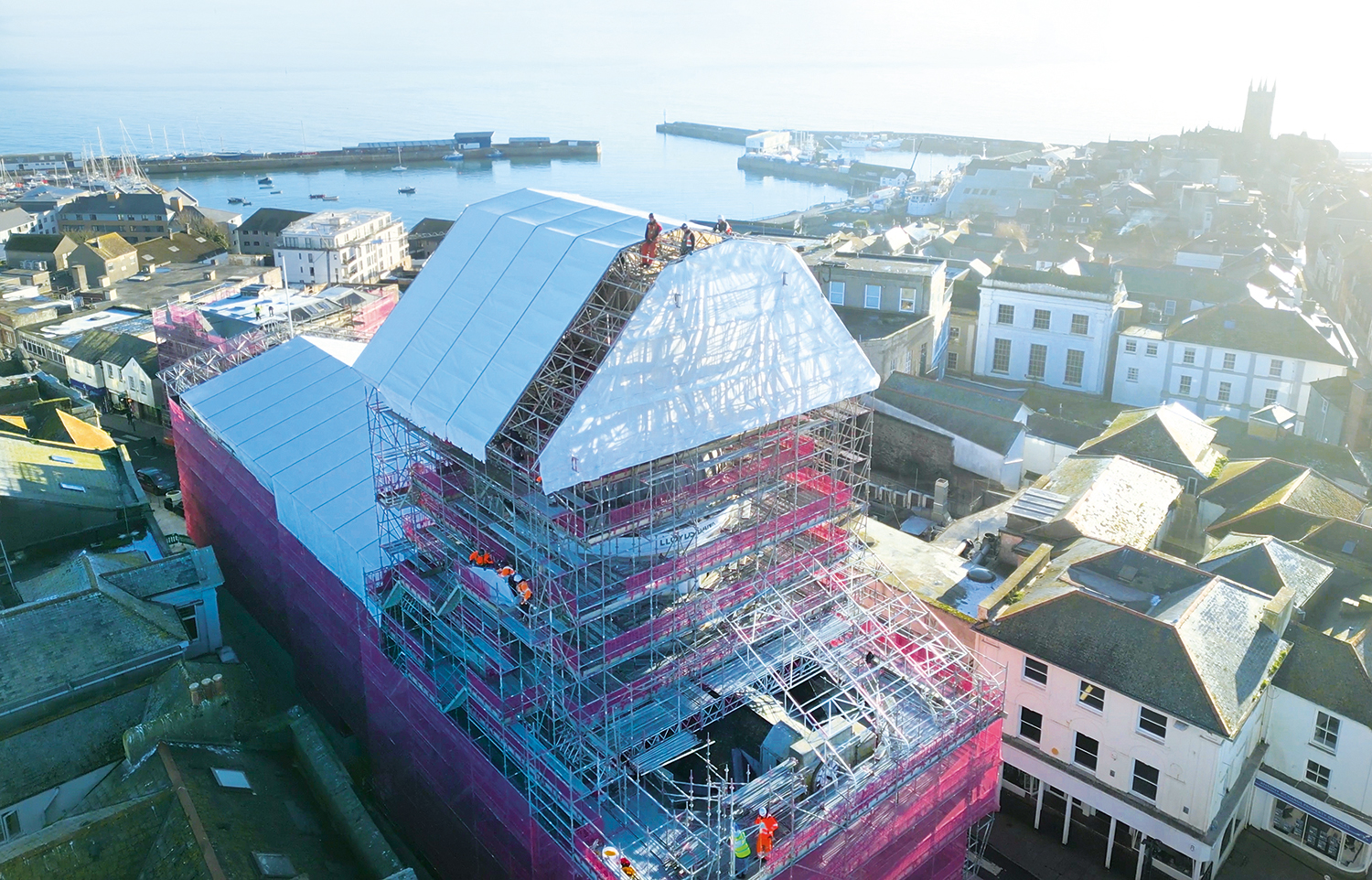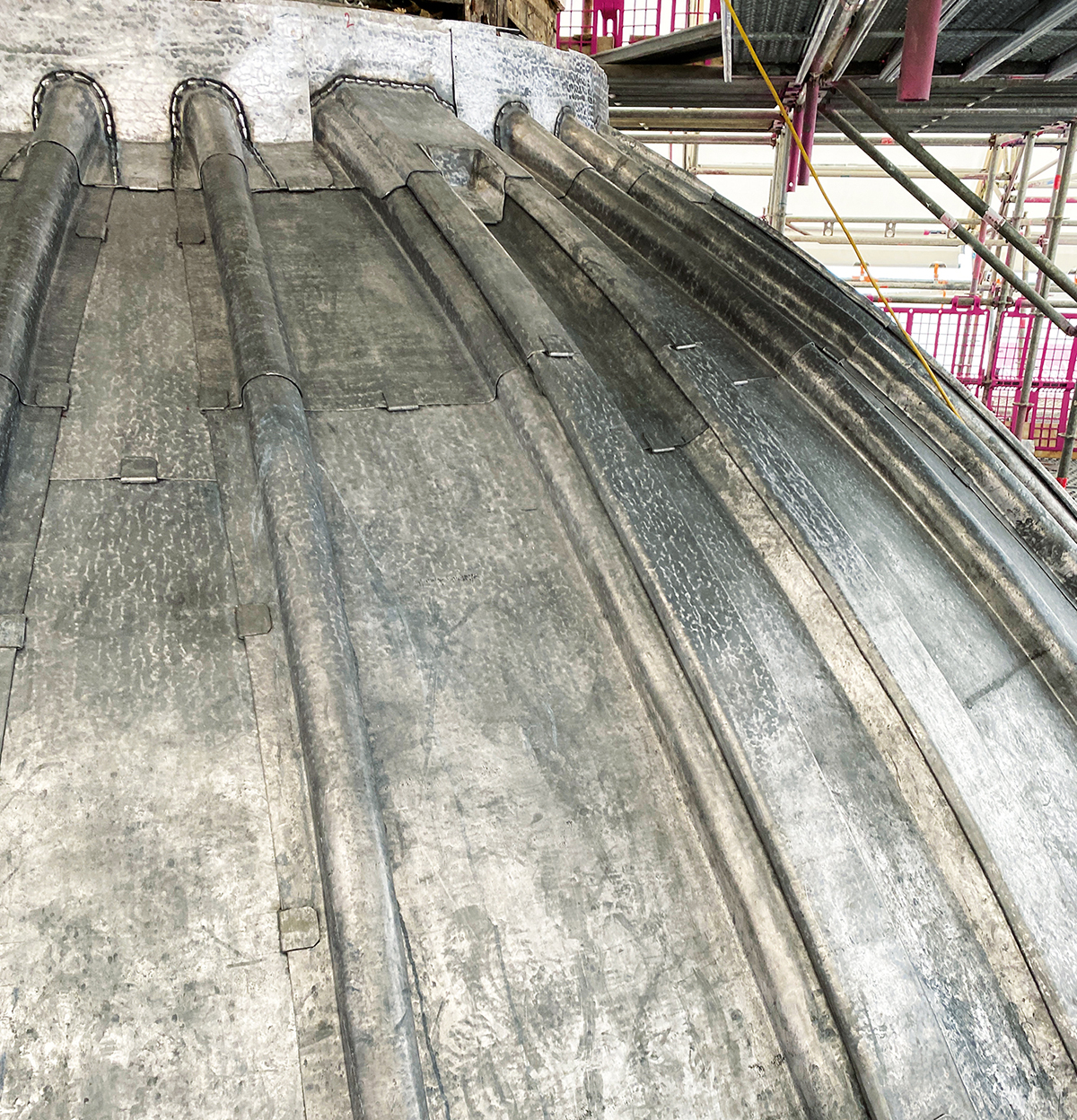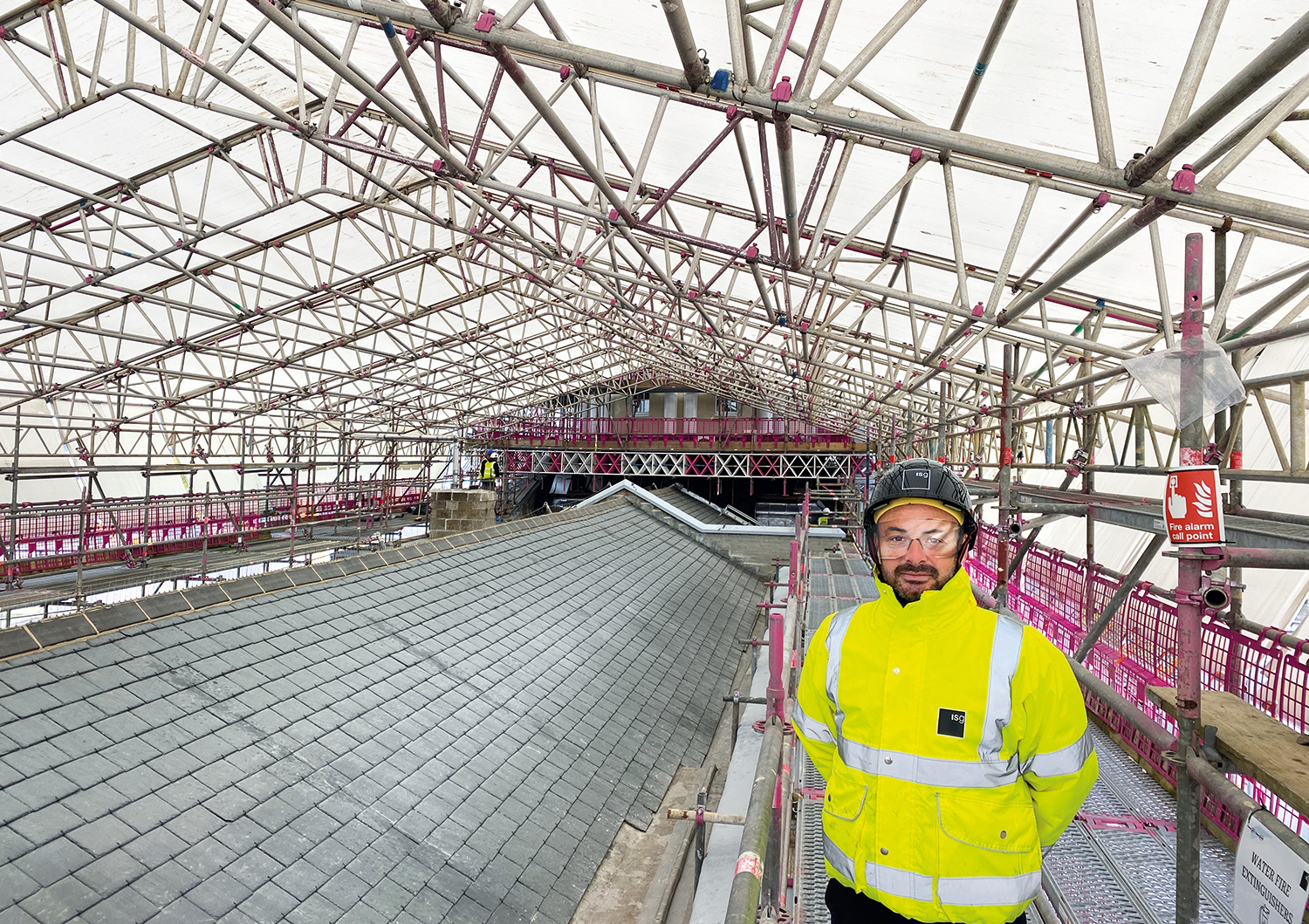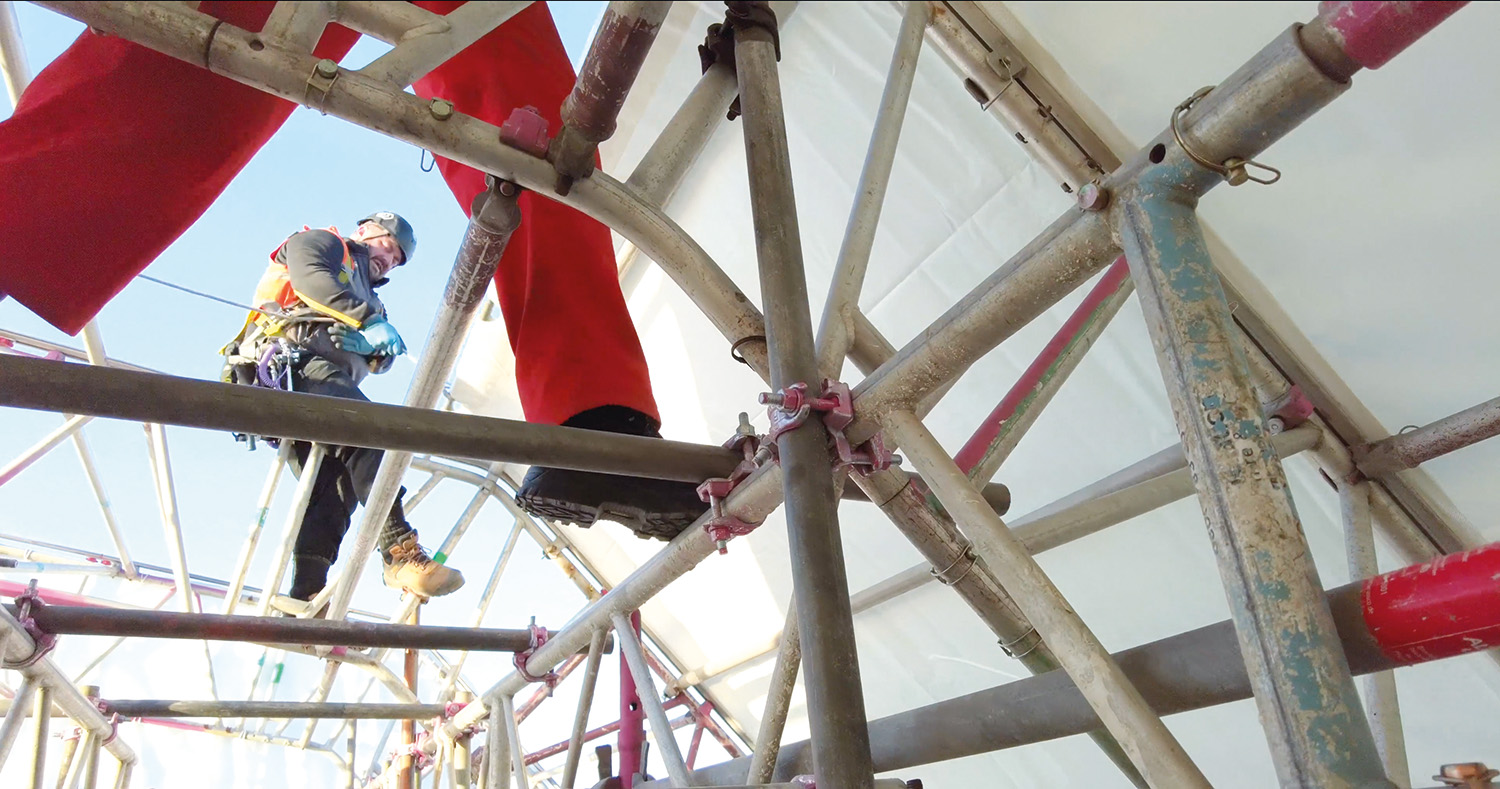
The Grade I-listed Penzance Market House is undergoing a vital roof restoration, courtesy of ISG. Will Mann reports from the far west of Cornwall.
The Penzance Market House dates from 1838 and its distinctive domed roof dominates the skyline of this Cornish port town.
But since the beginning of the year, the Grade I-listed building – some 34m high, 24m wide and nearly 100m long – has been hidden inside a giant temporary scaffold structure wrapped in fetching pink sheeting, while vital heritage repairs are carried out.
Penzance Market House
Value: £1.7m
Main contractor: ISG
Programme: January to July 2024
Key suppliers
Joinery repairs and decorations: Jobson Decorators
Doff cleaning and pointing: Capital Stone
Lead specialist: EWN
Scaffolding: Chris Sedgeman
Wear and tear over the years had led to water ingress and damage inside the vacant eastern end of the building and the basement. The western half of the building has been occupied for 99 years by one of the UK’s top five retailer banks, which brought in its construction framework partner ISG to assess the damage, carry out interior repairs, and scope out the works required to the roof and building fabric.
ISG progressed this work through 2021 and 2022, but after a drone survey and closer investigation of the roof condition, it became clear that this would be a bigger job than first expected.
“It was evident that the lead was past its sell-by date,” says Matt O’Hara, ISG site manager on the project. “Originally we were planning patch repairs, but after advice from lead specialists and English Heritage, the only solution was to replace the lead on the whole dome head.”
It wasn’t just the lead that was damaged. The Market House looks like a typical Cornish granite building, but the structure above ground and first floor level is timber, including the dome and roof over the eastern end of the building. Some of the timber structure had rotted and needed strengthening. The total project cost is £1.7m.
Understanding the original building
“I’ve worked with the bank for 15 years on many of their branches and offices, but this is a project unlike any other,” says O’Hara. “We are working with local historians, Historic England and the council planning authorities to understand the original construction of the building, and we are carrying out like-for-like repairs with the same materials.”
Leadwork specialist EWN is replacing the lead roof sections. “The Market House is like a smaller version of St Paul’s Cathedral roof – but it’s a bit windier here!” says director Elliot Newman.

A challenge for EWN is shaping the lead to fit the dome – the process known as bossing.
“We have created 10 different shaped moulds to reflect the curve of the dome – you obviously need a different form at the top of the dome where it narrows into the octagonal lantern compared to at the bottom where it’s wider,” Newman explains.
“Hot works can’t be used here because of the heritage status and fire risk so these are created away from the site by joiners. We boss the lead using the mould in the hot works zone, and then bring the lead back to install on the roof.
“The original lead rolls were too large, probably about 800mm wide, and they’d expanded and contracted with the weather, and cracked in places, which led to the leaks.
“The new lead rolls will be the standard 450mm. There were no regulations in the days when the roof was built so we’re bringing it up to today’s standards. We’re also fitting extra clips to hold them in place, which we wouldn’t do typically but given the weather conditions here, a ‘belt and braces’ approach is sensible.”
Breathable heritage paint

The sand-cast lead is a dull grey appearance at present, but Newman explains that once it has rained, the dome will change colour to “a light grey, which is what the original roof would have looked like”.
The dome roof sits on an octagonal drum ringed by 16 Doric columns which are also timber and have required repainting, this time with a specialist heritage paint that is breathable. O’Hara notes that the condition of the columns is “incredible” given that only the paint was protecting the timber from the elements for nearly 200 years.
Four wooden ‘scroll’ details around the base of the drum are being carefully repaired, in one case off site, by a specialist in London.

The pitched roof on the eastern side of the building has also required repairs, with around 100 new slates fitted and the flashing replaced. “Previously the gullies had been getting blocked, and where the flashing hadn’t been fitted properly, water was running into the building and down into the basement,” O’Hara says.
ISG has had to strengthen one of the main joists that was damaged by leaks. “We found a local sawmill, certified by English Heritage, and amazingly they have the same timber from nearly 200 years ago,” explains O’Hara. “That’s where all the timber comes from that we’re installing here.”
Building fabric condition
ISG has cleaned the Market House stonework, using a steam cleaner, which first required four different pressure patch tests to check it would not damage the stone or mortar.
“Where mortar had crumbled and failed, a sample was taken away for laboratory analysis, with the heritage team agreeing a replacement lime mortar mix to use which is as close to the original as possible,” adds O’Hara.
The original sash windows are being repaired and glazing replaced where necessary, typically where the beading had crumbled.
“The condition of the building fabric is generally worse on the seaward, west-facing side of the building, where the weather comes from,” O’Hara says.
He is logging the condition of all the assets on the building which will be handed over to the client on completion.

O’Hara is Kent-based and travels down every couple of weeks to spend a few days in Penzance on the project. He joined construction in 2005 after a football career with Gillingham FC’s academy was cut short by injury. Starting out as a shopfitter, taking an apprenticeship, he moved up to site management, joining ISG and becoming a specialist on its retail bank work.
Learning experience
He says the heritage aspects of the project have been a terrific learning experience. “We’ve had great advice from Catherine Marlow at Historic England, Chris Miners at English Heritage, local historian Eric Berry, plus Hannah Williams and Colin Buck from Cornwall Council,” he says.

As well as working with heritage experts, O’Hara was able to give work to a homeless person who used to sleep on the steps of the Market House, and asked if there was any work available. “We gave him some labouring work and helped him get his CSCS card, and since then he’s managed to save some money and get himself somewhere to live and move into full time employment,” O’Hara says.
By the end of July, the 24-week construction programme will be coming to an end, the scaffolding should be ready to come down and the restored Market House will be back on show in the heart of Penzance.
‘This is the first time we have ever covered a dome’
Chris Sedgeman runs the contractor with the distinctive pink scaffold sheeting.

Facilitating the whole Market House project is the 38m-high temporary works structure which encapsulates the building and runs to 17 floors of scaffolding.
It was erected by Chris Sedgeman Scaffolding, a Penzance firm but a major national player.
Managing director Chris Sedgeman (pictured above), from up the road in St Just, came up with the idea of pink branding 30 years ago, meaning that building sites all over the country feature his distinctive scaffold sheeting.
“We’ve put scaffolding around a lot of unusual buildings, but this is the first time we have ever covered a dome,” says Sedgeman.
“It is a complex building to put scaffolding around, because of the circular shape of the dome, and the ins and outs of the facade. But we model the scaffolding digitally first and with this modular scaffold system we can work to a tolerance of 50mm.
“The other advantage of the modular system is that it provides clear access for ISG’s team and the trades to get around the structure.”
The structure was erected between October to January, using a winch system. Putting up the scaffold and managing site logistics has been “challenging”, says O’Hara.
As the Market House is in the middle of Penzance, on the town’s busy Market Jew Street, no road closures were permitted, and all of the deliveries had to come in at the eastern end of the site.
Comments
Comments are closed.












It’s very interesting to read about the work that’s taking place. Here’s a suggestion. Print out what has been described above and display the information on boards outside the building. It may stop the people here in Pz griping and wondering.
We came to Penzance today was pouring with rain would have been nice to see it in it’s glory but we come from Essex so not sure when or if we will be back.
Good idea because it’s a really interesting read.
I agree! Excellent idea.
An interesting and informative article. So pleased this iconic building is being sensitively restored.
So interesting to read all this, what a group of artisans from Sedgeman’s incredible scaffolding art to the amazing lead workers! And all we see is the pink net around the building not realising what’s going on behind the scenes!
Whilst I admire and applaud the renovation by works done here I often felt that a golden roof would look rather nice on this building, rather like the ones you see in the Middle East or India. Lead grey is a rather dull and boring colour but gold would be an amazing sight to behold and reflect the enormous ongoing wealth of Lloyds Bank, who would, I’m sure, be eager to pay for it.
This is so interesting. There were a lot of skills used in the restoration. My dad used to clean the windows of Lloyds Bank. He’d love to read this. Also I love the story of the homeless man and how he’s been given a chance. Well done everyone.
Really interesting and positive. I can’t wait to see it finished.
That was a really interesting read. I loved learning about how the construction was planned and how those working on it have enjoyed learning so much about the 200 year old building. The lead process is also fascinating. Great that a homeless person has gained work and enabled to find a home through the project. Thank you for sharing this fascinating local news.
An excellent suggestion. Please do this. Other restorations/repairs should take note. Communication through basic channels and simple methodology is crucial for town and community developments. Local criticism is very often due to the lack of background and other knowledge and how to access it non-digitally.
Incredible work, thank you to everyone involved. Can’t wait to see all the beautiful restoration work and to have the dome back on the skyline. Also very positive to read about the help given to the homeless person. 🤗
Interesting read, my niece who lives in New Zealand sent this article to us via our family WhatsApp. Like the previous comment, it would be nice to have it displayed on site for everyone. My father in law, whilst working for local painter & decorating firm Wakfers, painted the windows many years ago.